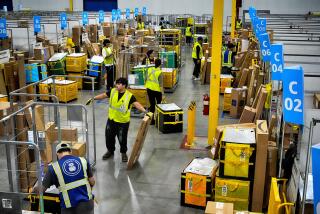Productivity Growth Is Best Since ’83
- Share via
WASHINGTON — The productivity of American workers climbed at its fastest pace in two decades last quarter, the Labor Department said Wednesday.
The new figures were the latest in a string of unexpectedly strong signals that the economy is finally on the mend, and prompted economists to predict that powerful job growth would follow shortly.
Output per worker at the nation’s nonagricultural businesses rose at a 9.4% annual pace from July through September, better than the 8.1% the department initially estimated and the best quarterly performance since 1983.
The upward revision brought to 5.5% the average for the last two years, the best two-year performance since 1953, according to Bank of America Corp.
But as with so much else about the nation’s latest bout of recession and recovery, there was a half-empty quality to the latest figures.
“In every prior recovery, early-stage productivity gains led to more jobs,” said Bank of America chief economist Mickey D. Levy. In the third quarter, however, virtually all the gains went to corporate profits, not higher wages.
“The combination of rapid productivity growth and anemic wage growth means that the benefits are going to corporate profits,” said Josh Bivens, an economist with the Economic Policy Institute, a Washington think tank.
Companies typically reap a substantial share of the gains from growth in the early stages of a recovery as profits rise and unemployment keeps a lid on compensation costs.
But the share that corporate America is reaping this time around appears outsized by comparison with other recoveries of the last half-century, and the share going to employees appears correspondingly small.
Bivens said government statistics showed that since the end of the recession in November 2001, workers had collected 29% of the growth in corporate income in the form of higher wages and benefits. The average at a similar stage in every other recovery of the post-World War II era was 61%.
The Labor Department said hourly compensation after inflation increased at a modest 0.7% pace during the July-through-September quarter. During the April-through-June quarter, it increased at a 3% rate.
The broadest measure of pretax corporate earnings tracked by the government rocketed to an annualized rate of $1 trillion in the third quarter from $897 billion in the second quarter, according to the Commerce Department. From the low point reached in the third quarter of 2001, earnings have rebounded nearly 50%.
Economists say that although there is no question that the jump in profits was partly because many companies have cut jobs to boost productivity, other forces also have been at work in repairing corporate finances.
For example, interest rates have been cut to 50-year lows by the Federal Reserve, reducing companies’ borrowing costs. And the slumping dollar has fattened earnings U.S. companies derive from foreign sales.
“All of this has given companies tremendous operating leverage,” said Joseph Carson, economist at Alliance Capital Management in New York. In other words, with just a small increase in sales, profits can boom.
And though workers may feel as if they haven’t shared much in the profit revival so far, many analysts say it’s inevitable that higher earnings will lead to more hiring and greater capital spending by businesses, further stoking the economic recovery.
The earnings rebound is “confirmation of a very vast and sustainable economic growth cycle” underway, Carson said.
In a separate report Wednesday, the Institute for Supply Management said its index of overall activity in the services sector of the economy fell to 60.1 in November from 64.7 in October. Even so, an institute index measuring employment activity rose to its highest level since March 2000, indicating a faster pace of hiring.
The next economic gauge comes Friday, when the government announces November’s employment figures. Most forecasters believe the economy added a net 150,000 jobs during the month.
If they’re correct, that would be the best monthly job performance since January, when payrolls grew by 158,000. It would extend a string of job gains that began in August. And analysts said it would show the labor market finally was improving at a fast enough pace to begin bringing down unemployment.
“Businesses have pretty much run out of room to make improvements by cutting jobs and getting productivity gains. Now they’re having to add employees,” said Jade Zelnik, an economist with RBS Greenwich Capital in Connecticut.
But many analysts predicted that the improvement would come at a slow pace.
Tony Anderson, area managing partner for Ernst & Young in Los Angeles, said he believed the economy was finally on the road to recovery. But Anderson said the latest productivity numbers suggested that job creation would not be strong enough to quickly replace the 2.4 million positions lost since March 2001, the start of the recession .
“If you lost 100,000 people” during the recession, Anderson said, “maybe 70,000 will come back.”
Times staff writers Tom Petruno and Rick Wartzman in Los Angeles contributed to this report.
More to Read
Inside the business of entertainment
The Wide Shot brings you news, analysis and insights on everything from streaming wars to production — and what it all means for the future.
You may occasionally receive promotional content from the Los Angeles Times.










